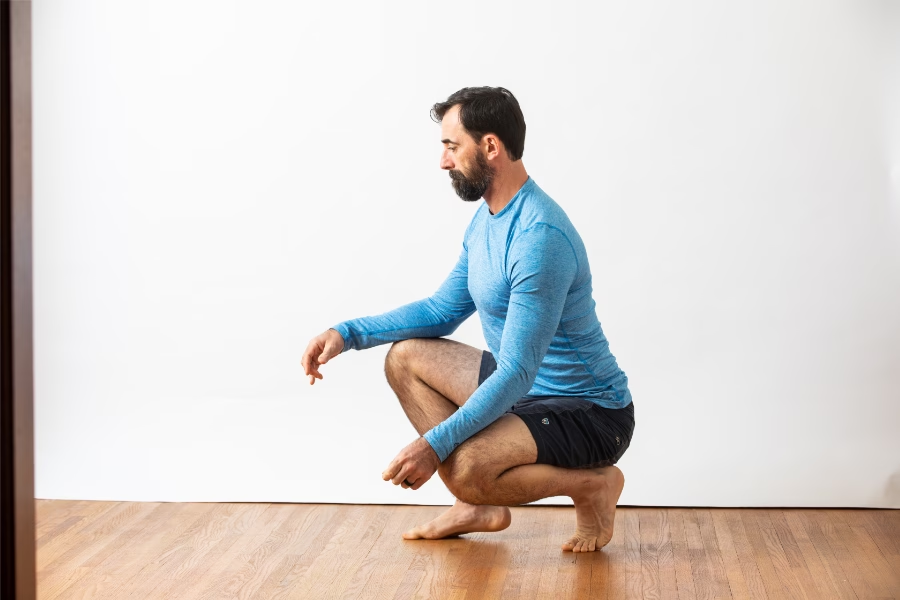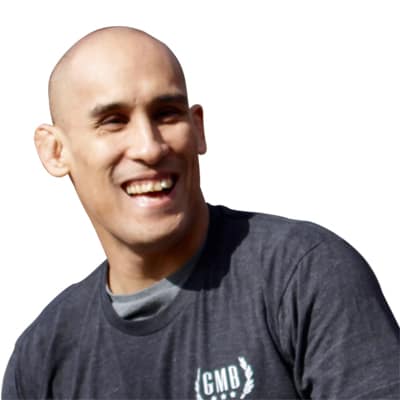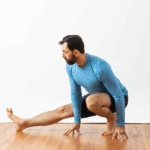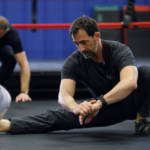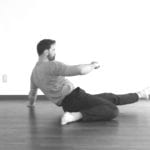Want a 3 second test to see how long you’ll live? Sit down on the floor and stand up without using your hands.
It sounds simple until you actually try it.
A few years ago, this widely reported study claimed this could predict how long you’ll live. Cue the flood of social media videos showing people trying to pass the test!
The sit to rise test shines a light on how difficult it is for you to get up off the floor, and it really is a big deal whether or not you can do it. And will be an even bigger deal 20 years from now, it’s one of the major factors in living an independent life.
So what does this test actually measure, and what should you do if it feels harder than it should?
The Sitting-Rise Test: What It Actually Measures (And What It Doesn’t)
Developed by Brazilian researchers, the Sitting-Rise Test (SRT) – also commonly referred to as the “sit to rise” test – scores your ability to sit down and stand up from the floor. The goal is to do so without using your hands or putting your knees down.
A perfect score is ten, with point deductions for using your hands, knees, or losing balance.
Over an average follow-up time of ~6 years, participants who scored in the lowest range (0–3 points) had a 5 to 6 times higher risk of death than those scoring 8–10 points. And every one point improvement in the score corresponded to a 21% decrease in mortality risk, regardless of age, sex, and Body Mass Index (weight to height ratio).
So people who struggled with the test are statistically more likely to die sooner.
…but correlation isn’t causation!
The ability to stand from the floor itself doesn’t cause longer life, it reflects the physical capacities that tend to support it: Strength, Balance, and Mobility.
“It’s not that getting off the ground makes you live longer. It’s that all the things that help you get up (flexibility, strength, control) are the same things that help you live better, longer.”
So what does the SRT actually reveal?
- Strength: Mostly hips, legs and core.
- Mobility: Especially through the hips, knees, and ankles.
- Balance and Coordination: Smooth transitions require body awareness and control.
You’re not doomed if you can’t do it right now!
It’s simply giving you valuable information on your current abilities and a perhaps an important wake-up call about how well your body is aging.
Can’t Do It? Here’s What’s Holding You Back
If this test is harder for you than it should be, don’t be disheartened, take that information and get to work. Here are the big three things holding people back. And they can absolutely be improved.
1. Strength Deficits
2. Mobility Restrictions
3. Balance & Coordination
Resource: Longevity Research Review & Recommendations
👉 How to Live Forever(or at least stay strong for a real long time)
How to Improve Your Sit to Rise Performance (and Actually Move Better)
If this test felt a lot harder to do than you’d like, here’s what you can do.
1. Need More Strength for Sitting and Standing?
It’s pretty obvious that it’s leg and hip strength that gets you off of the ground in this test. Your ability to create force is a key factor here, you need to be able to generate enough power to rise up. A simple and effective way to start is to practice squats in a variety of ways, get strong by learning to move well!
View this post on Instagram
There’s dozens of ways to build lower body strength, but the most efficient way to gain functional and practical hip and leg strength is to work on the various angles and positions in squats, lunges, and everything in between on the ground.
You’ll gain strength in areas you didn’t even realize you could, and also work on your flexibility at the same time.
2. Limited Mobility to Move On the Floor?
This leads us to the next common restriction in standing up, which is limited mobility. Decreased flexibility has been linked to trouble getting up off the floor.
View this post on Instagram
Individual stretches can be very helpful if you are significantly limited in your range of motion, particularly at your hips, and are best used as supplements rather than your main training. You can stretch for hours, but until you learn how to move better and use the most out of that range of motion, you’re not making the best out of your training time.
As you noticed above, working on squats and lunges through your current available range of motion, and playing with lots of different angles and simply spending more time on them (and on the ground) will dramatically improve your mobility.
This will absolutely make getting up much easier!
3. Need Work on Balance and Coordination?
Losing your balance or tipping over isn’t because you were “born clumsy”, it’s often a breakdown in how your body organizes movement. This includes sensory input (what your joints feel), motor control (what your brain tells your muscles to do), and timing (how you sequence your movements).
View this post on Instagram
The Sitting-Rising Test is overall a “simple” thing to do, but it forces all of those systems to work together in real time.
If you find yourself wobbling, hesitating, or unconsciously dropping a hand or knee down for support, that’s your body telling you, “I don’t quite trust this.”
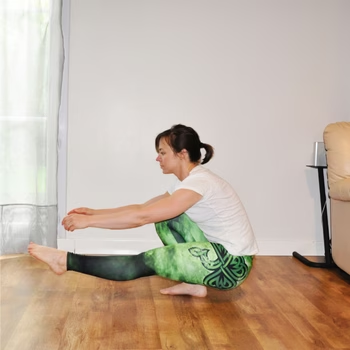 Thankfully you can rebuild that trust!
Thankfully you can rebuild that trust!
- Slow down the movement: Give your body time to feel where it’s unsteady.
- Repeat transitions often: Repetition builds motor learning, especially when done with deliberate intent.
- Change the conditions: Try the same move on a soft mat, with eyes closed, or with an object in your hand.
Variety improves adaptability.
Locomotion patterns, such as we teach in Elements (the Bear, Monkey, and Frogger) trains these coordination patterns, which translates directly into better real-world balance.
Retraining how your body sequences movement builds how confidently it can respond to the world around it.
Beyond the Test: Why Standing Up Easily Actually Matters
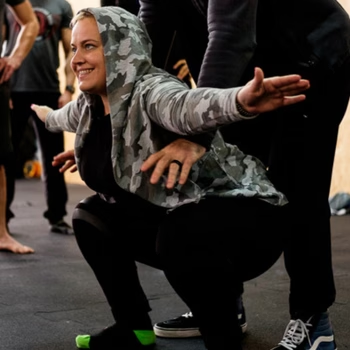 Forget about the sit to rise test itself for a minute and look at what it’s really telling you. It’s a snapshot of your functional independence.
Forget about the sit to rise test itself for a minute and look at what it’s really telling you. It’s a snapshot of your functional independence.
If you can’t get off the floor easily now, what will it be like in 10, 20, or 30 years?
You don’t need to drop everything and overhaul your life, but standing up off the floor is a fundamental ability. And making this easier to do will pay off in the future.
We talk a lot about finding the best consistent and sustainable ways for you to train because it’s incredibly important in achieving not just a long life, but a healthy and fit one.
But What If I Can’t Do It the “Right” Way?
Now quite a few people look at the Sitting-Rising Test and immediately clock out:
“I’ve got bad knees.”
“I can’t squat like that.”
“You can only do that if you’re already fit.”
Yes, a lot of us are dealing with chronic injuries and conditions, and they can have very real limitations. But quite frankly, giving up on this right away is limiting you more than just about any other issue.
Here’s one alternative approach:
If you need to use both your hands right now, how about working towards using just one? And then working towards less and less assistance with that one hand.
Or if your knees are hurting, can you figure out an angle that’s just a little bit less sore and work on that?
I’m absolutely sure that you can find strategies that work for you.
Finding Your Own Solutions to Movement Challenges
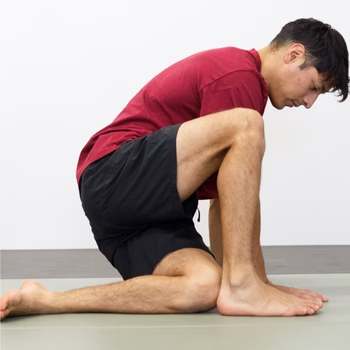 The sit to rise test isn’t meant to be something you “pass” with the “correct answers”, it’s a way to see how your body is functioning today and gives you insights into what’s possible with focused practice.
The sit to rise test isn’t meant to be something you “pass” with the “correct answers”, it’s a way to see how your body is functioning today and gives you insights into what’s possible with focused practice.
Physical limitations don’t make you incapable.
They just mean your approach needs to be more specific.
We’ve worked with thousands of people dealing with joint issues, pain, past injuries, or just years of moving less than they’d like, and they’ve all been able to improve.
Stop chasing an idealized form and start working with your actual body. Spend a little time each week working on how you move.
Build practical strength and mobility in the actions you actually need to do everyday!
Live Longer Better
Physical fitness is obviously correlated with longevity, but more importantly it determines your ability to live without assistance.
That’s why we’ve named what we do Physical Autonomy.
I’ve seen this firsthand in hospitals and clinics; 50 year-olds that look and move like they’re 90, and 90 year-olds that move better than 50 year-olds.
That’s why our core philosophy is:
Train to move well, so you can do whatever you want for as long as possible.
You don’t need to train like a pro athlete.
Find what you can do to move like someone who wants to keep living on their own terms.
Build Your Capacity for a Long, Active Life Now
Longevity and living better in that time requires more than passing a test. You have to build and keep the qualities that provide you the freedom to move, play, and live the way you want.
If you want to move better and stay capable, don’t wait until it’s a problem, start today.
